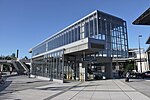Husky Stadium

Husky Stadium (officially Alaska Airlines Field at Husky Stadium for sponsorship purposes) is an outdoor football stadium in the northwest United States, located on the campus of the University of Washington in Seattle, Washington. It has been home to the Washington Huskies of the Pac-12 Conference since 1920, hosting their football games. Aside from football, the university holds its annual commencement at the stadium each June. It sits at the southeast corner of campus, between Montlake Boulevard Northeast and Union Bay, just north of the Montlake Cut. The stadium is served by the University of Washington Link light rail station, which provides rail service to downtown, Rainier Valley and Seattle–Tacoma International Airport. It is also accessible by several bus routes. The stadium underwent a $280 million renovation that was completed in 2013. Its U-shaped design was specifically oriented (18.167° south of due east) to minimize glare from the early afternoon sun in the athletes' eyes. The stadium's open end overlooks Lake Washington and the Cascade Mountains, including Mount Rainier. Prior to the 2013 renovation, its total capacity of 72,500 made it the largest stadium in the Pacific Northwest and one of the largest college football stadiums.
Excerpt from the Wikipedia article Husky Stadium (License: CC BY-SA 3.0, Authors, Images).Husky Stadium
Montlake Boulevard Northeast, Seattle University District
Geographical coordinates (GPS) Address External links Nearby Places Show on map
Geographical coordinates (GPS)
| Latitude | Longitude |
|---|---|
| N 47.6503 ° | E -122.3016 ° |
Address
Husky Stadium
Montlake Boulevard Northeast 3800
98105 Seattle, University District
Washington, United States
Open on Google Maps







